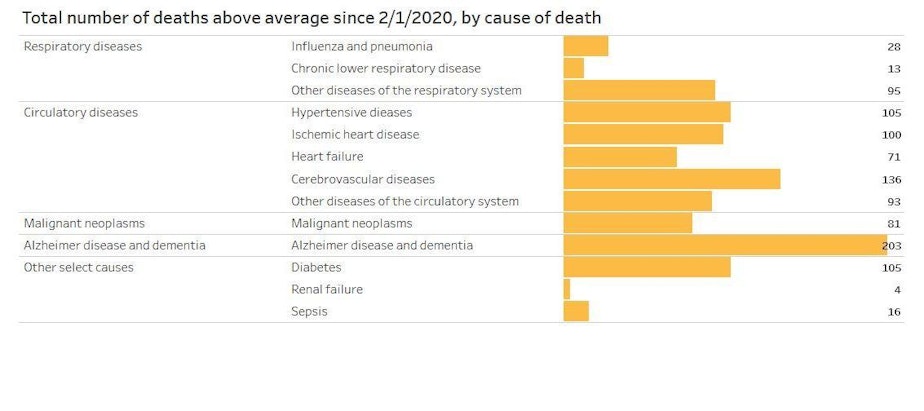Official Covid-19 fatalities may undercount pandemic's death toll by many hundreds in NW
The carefully followed death toll from Covid-19 may not fully capture the loss of life during the pandemic. Analysis of Washington state and federal statistics for deaths from all causes shows hundreds of additional deaths above normal levels this spring in the Pacific Northwest. Some or many of those may actually be missed Covid deaths.
In the medical field, deaths above what you would normally expect are called "excess deaths." On a percentage basis, total deaths between March and early June were about 3% higher than usual in Oregon and 6% higher in Washington state, which was actually considerably better off than the nation as a whole where the New York Times calculated 20% higher than average deaths during the period.
"Really looking at the total number of deaths, and whether it was excess compared to what happened in the last few years, gives some indication as to the total burden that the Covid pandemic is producing in the community," said University of Washington professor Anirban Basu.
RELATED: 'It was bad.' Three hours on the Covid ICU in Seattle
Basu was one of several experts we consulted to evaluate the true impact of the pandemic. He studies Covid-19 fatality rates while directing the UW's Comparative Health Outcomes, Policy, and Economics Institute.
The federal Centers for Disease Control and Prevention (CDC) and the Oregon and Washington state health departments provided us data on deaths from all causes -- not just Covid-19.
Those numbers showed that between late March and early May, there was a spike in people dying from other causes alongside the peak in Covid fatalities. The noticeable collateral damage spanned about seven weeks in Washington and around six weeks in Oregon.
Sponsored
Idaho's 2020 total death toll in this period was close to normal, which makes sense given that the pandemic surged more recently in the Gem State.
Based on observed deaths and modeling, the CDC on July 8 estimated 900 more deaths than usual have occurred in Washington state since February and as many as 478 more in Oregon. In the case of Washington, that's actually fewer deaths than the running total of Covid-19 fatalities (approx. 1,350 as of last week), which may indicate incomplete data. Another possibility is Covid has partially replaced other causes of mortality that would have otherwise brought imminent death to some people.
All of the government and academic teams gauging excess deaths in the pandemic cautioned that they are working with preliminary data. Death certificates take one to eight weeks, or longer, to be processed and cataloged. Final, verified numbers on deaths in the first half of this year won't be available until 2021.
Washington State Health Officer Dr. Kathy Lofy said many of this spring's excess deaths might actually be unrecognized Covid cases.
"A lot of the thinking is that they may be related to Covid in some way," Lofy said during a briefing. "If they have an underlying heart or lung condition, they can die from that heart or lung condition and it may not even be recognized sometimes that they really did have Covid-19."
Sponsored
"We are certain that there are people dying of COVID who never are tested, and so are not picked up in our situation," Washington Gov. Jay Inslee added during a press conference in Olympia Tuesday. "There is an increasing recognition of that phenomenon across the country."
The CDC tally of excess deaths shows the highest departure from normal since February among people with Alzheimer's disease and dementia. The stroke and diabetes categories also stand out.

The disruptions of the pandemic could cause a more rapid decline in patients who were fragile to begin with. Carrie McBride, marketing and communications director for the Washington state chapter of the Alzheimer's Association, said this has been "a really difficult time" for the people her nonprofit serves.
"We're just hearing that the social isolation, and the added stress of everything that's been happening and the disruption to people's routines, a lack of resources and respite, is really taking a toll on these families," McBride said in an interview.
Sponsored
This rings true for Susan Weber of Seattle. Her mother, Helen Molina, was in an assisted living center with late-stage Alzheimer's when the pandemic started, then caught the novel coronavirus and died from it.

"One thing that I learned through the Alzheimer's group was how much routine and continuity was important for not only their mental health, but just for slowing the decline," Weber said in an interview.
Weber said she was unable to see her mother in person for the final three weeks of Molina's life because of Covid precautions.
"All of a sudden we weren't there," Weber said about the forbidden family visits. "They are literally in their room by themselves all day except for getting meals. It was one of those frustrating things."
Weber said the death certificate for her 85-year-old mom correctly listed Covid-19 as the cause of death with Alzheimer's as an underlying condition.
Sponsored
The Alzheimer's Association would like to see shortages of protective equipment addressed, and more coronavirus testing done in long-term care facilities and nursing homes. Washington's Department of Health recently completed a push to test all residents and staff at every nursing home in the state.
"It is difficult for someone who cares about this cause so passionately to hear that professional athletes, for example, are being tested every other day when the population that is probably most vulnerable in all of this is just being tested once, if they consent," McBride said in an interview.
In the early weeks of the pandemic, emergency rooms recorded a drop in visits as some people avoided going near hospitals to limit their potential exposure to the novel virus. This behavior raised concern in the medical profession about timely treatment of strokes and heart disease.
"Evidence suggests that patients with heart attacks and strokes delayed seeking care due to the COVID-19 emergency, which would explain excess mortality," wrote the authors of a recent paper in the online journal medRxiv. "Reduced care seeking could contribute substantially to excess mortality."
However, Basu and Washington state's coronavirus "hospital czar" Dr. Raquel Bono both said last week that there was no evidence in the mortality data of any significant spike in deaths attributable to people delaying necessary hospital care.
Sponsored
Despite heightened mental stress and widespread job losses, there is also no discernible increase in suicides during the pandemic, judging from year-to-date data provided by the Washington State Department of Health.
The surge in excess deaths seems to have tailed off in the month of May in the Pacific Northwest. Lately, even with ongoing Covid fatalities in the mix, the number of weekly deaths from all causes appears to be within the normal range. That trend ameliorated UW professor Basu's concern.
"That indicates either more attention being paid to these residents in long term care facilities or because we are now capturing the Covid deaths more accurately," Basu said.
Washington's Department of Health said Tuesday it sped up the normally slow process of recording death certificates "to support a rapid and informed response" to the pandemic. Epidemiologists continue to search for sectors with excess deaths that could reveal pockets of coronavirus needing attention.
"The million dollar question is what happened with everything else," said state Department of Health epidemiologist Victoria Lazariu in an interview Tuesday. "There are a lot of moving pieces. Hopefully, with time we'll be able to make sense of this."

